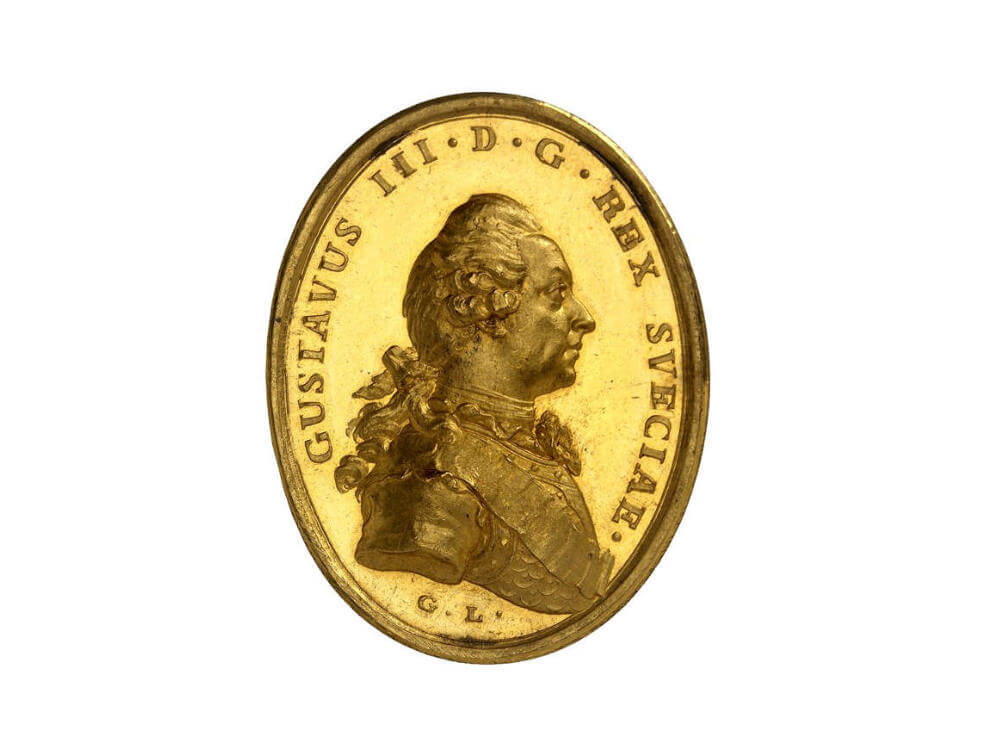Gustav III: A Conservative Revolutionary
Gustav is said to have been enjoying himself in a Paris theatre when he was informed about his father’s passing and told that he would henceforth rule the Swedes as Gustav III. This was in 1771, and conflicts were brewing all over Europe. The rising bourgeoisie demanded more rights; the still powerful nobility insisted on its privileges; and the peasants complained of poor harvests due to bad weather.
Content
Gustav III recognized the potential for a crisis. He feared that the king’s position might be compromised in the struggle between the bourgeoisie and the nobility. He therefore decided to de-escalate the situation by launching a coup d’état himself: he stripped the nobility of some of their privileges, introduced long-overdue reforms and used the temporary truce at home to improve Sweden’s position in Europe.
Gustav III recognized the potential for a crisis. He feared that the king’s position might be compromised in the struggle between the bourgeoisie and the nobility. He therefore decided to de-escalate the situation by launching a coup d’état himself: he stripped the nobility of some of their privileges, introduced long-overdue reforms and used the temporary truce at home to improve Sweden’s position in Europe.
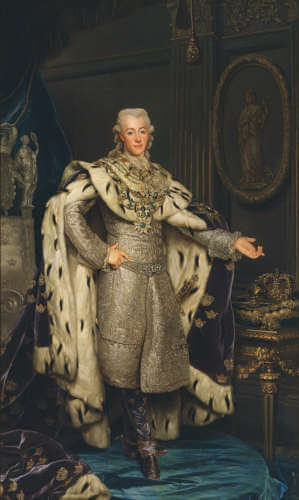
Gustav III wearing his coronation robe. Painting by Alexander Roslin from 1777. Gripsholm Castle NMGrh660.
A Swedish King from Northern Germany
Gustav III’s pragmatic approach is perhaps best explained by the fact that his relations with the old Swedish nobility were not as close as it was custom in other countries. After all, his family was not from Sweden but from northern Germany. Gustav’s father, Adolph Frederic, head of the younger line of the Oldenburg noble family of Schleswig-Holstein-Gottorf, had been Prince-Bishop of Lübeck before being elected heir to the Swedish throne in 1743 – incidentally just a few months before his great cousin Peter was appointed Tsarevich of Russia.
In 1751, Adolph Frederick was crowned, making five-year-old Gustav crown prince. In line with the spirit of the time, the latter was educated according to the ideals of the French Enlightenment. This means that Gustav learned to see his position as that of an enlightened monarch, on whose wise decisions the welfare of his country would depend.
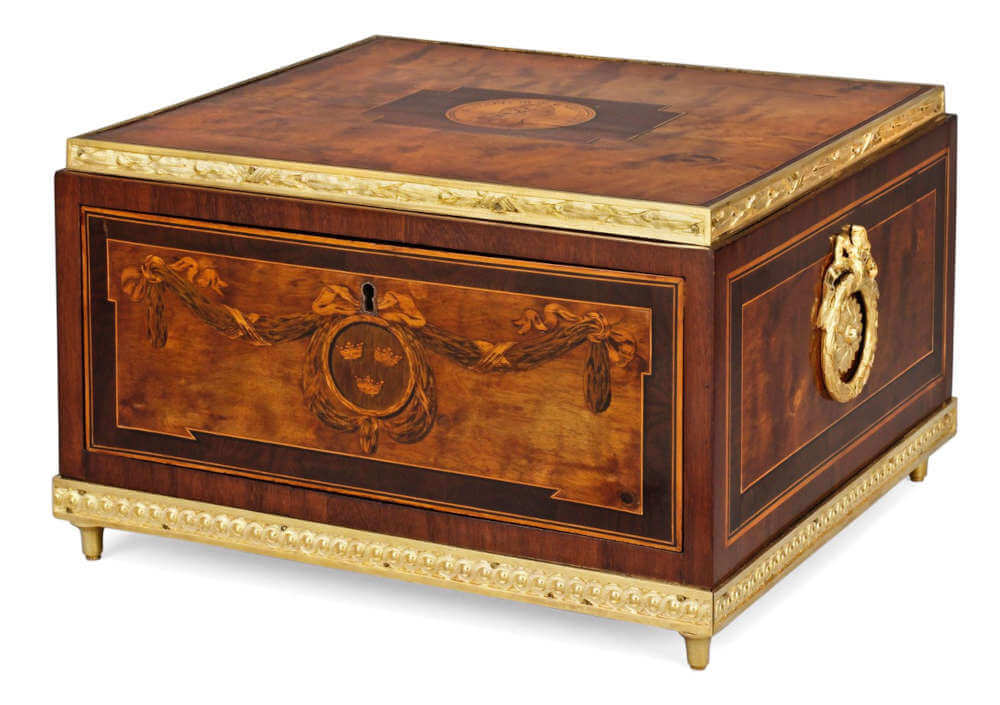
The coin cabinet used by Gustav III to hand over a collection of gold medals to Peter Frederick Louis in 1780. It was created by Georg Haupt and sold in 2009 for 1,500,000 kronor (= ca. 130,000 euros / hammer price). From Bukowskis, Höstens Klassiska auktion 554 (24 November 2009), No. 800. Photo: Bukowskis. We would like to thank our Swedish colleagues for allowing us to use this image.
A Ruler’s Present
We do not know why Peter Frederick Louis of Holstein-Gottorf, the future ruler of Oldenburg and Lübeck, travelled to Stockholm in 1780. Perhaps he had to discuss some family matters regarding Peter Frederick William, who had been declared unfit to rule due to mental illness by his relatives, and in whose place Peter Frederick Louis had governed since 1777.
But we do know about the present that Gustav III gave to his relative on this visit: an elaborate coin cabinet adorned with intarsia created by the Swedish artistic carpenter Georg Haupt. On six trays, it contained a total of 65 gold medals with the weight of more than four kilograms(!). Most of them were not from the possessions of the Swedish but of the Oldenburg family. They had been part of the collection of Adolph Frederick, Gustav’s father. Thanks to the account of a contemporary witness, we also know what Gustav III said when he handed over the coin cabinet to the young Oldenburg ruler: “Cette collection qui contient l’éloge de votre famille vous sera sans doute agréable, mon cousin; je vous prie de l’accepter comme souvenir d’un ami et d’un bon parent.” (= This collection, which contains the praise of your family, will undoubtedly be pleasant to you, my cousin. I kindly ask you to accept it as a souvenir of a friend and a good relative.)
Peter Frederick Louis did just that and the coin cabinet became part of the Oldenburg family estate until the deposed Grand Duke Frederick Augustus had the Riechmann company in Halle auction off its contents in 1924. He planned to use the proceeds of the sale to set up a modern meat processing facility. He was in need of additional funding because hyperinflation had caused the means to evaporate that he had generated from the sale of the most valuable 100 works of his picture gallery in the Netherlands – including works by Rembrandt, Rubens and Ruisdael. The export of these paintings, which the Free State of Oldenburg would have liked to purchase itself (but not at the price set by the Duke), resulted in Germany adopting its first cultural property protection act in the December of 1919.
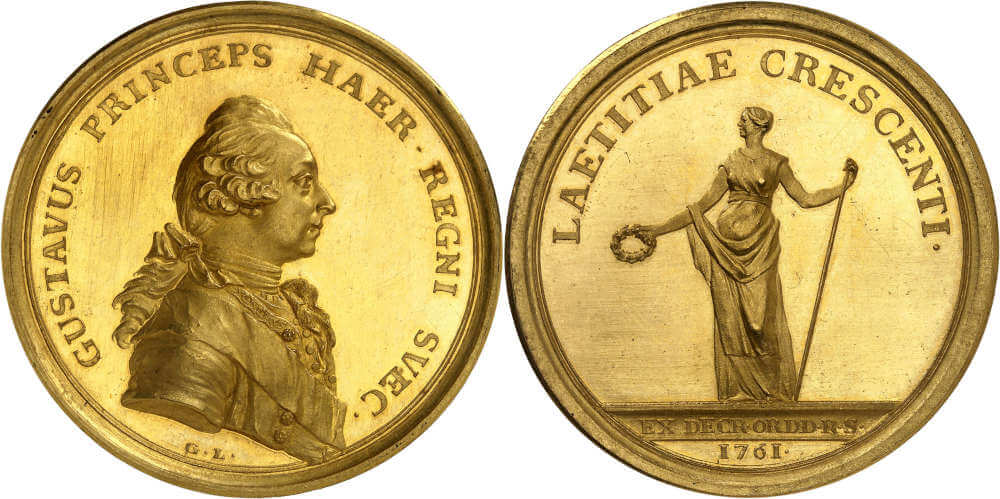
Gustav III. 1761 gold medal of 27 ducats, celebrating the 16th birthday of Crown Prince Gustav on 24 January, created by Gustaf Ljungberger. From the Gunnar Ekström Collection. Very rare. Extremely fine to FDC. Estimate: 20,000 euros. From Künker auction 387 (20 June 2023), No. 19.
The gift included three gold medals featuring the portrait of Gustav III, which will be offered on 20 June 2023 as part of the Gunnar Ekström collection by the Künker auction house. Gustav III had carefully selected these issues for programmatic reasons. The first of them depicts him as a young crown prince on his 16th birthday, the legal age of the time. The reverse shows Laetitia, a deity known from the ancient context, who can already be found with her wreath on the coins of Roman emperors.
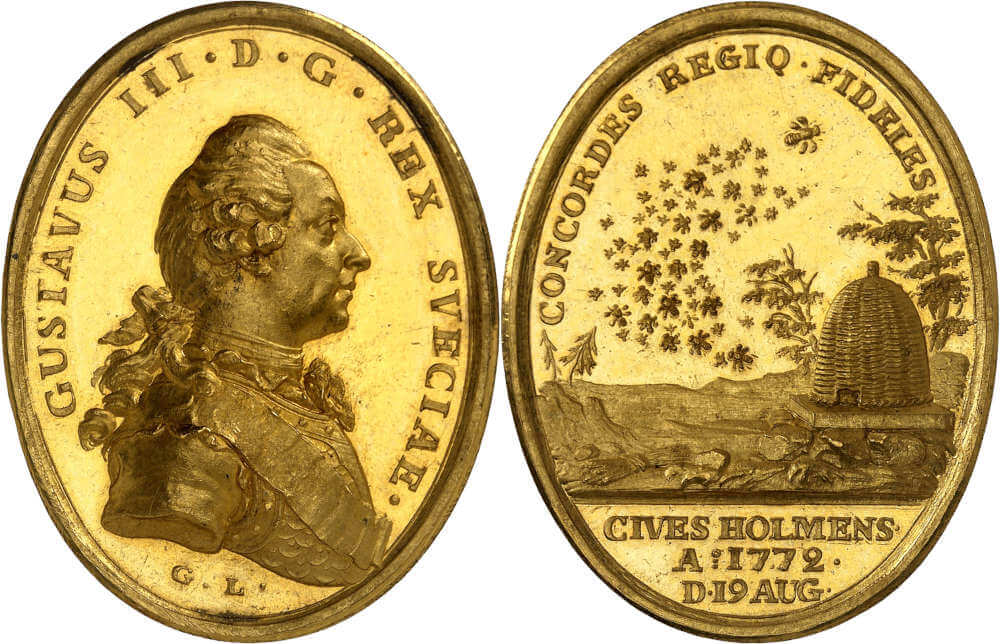
Gustav III. Oval gold medal of 8 ducats, commemorating the coup d’état of 1772, created by Gustaf Ljungberger. From the Gunnar Ekström Collection. Very rare. Extremely fine to FDC. Estimate: 7,500 euros. From Künker auction 387 (20 June 2023), No. 20.
A second medal from the ensemble is reminiscent of Gustav III’s coup d’état. After his success, Gustav III distributed gold and silver versions of the medal to all those who had supported him. The Latin circumscription refers to this, its translation reads “United and faithful to the king, the citizens of Stockholm in 1772, on August 19.” The bees that follow the lead of their queen leaving the old beehive to find a new home illustrate the legend.
In fact, the coup d’état was greeted by the inhabitants of Stockholm with great approval. Many of them sang “Gustavs Skål” at the time, a song written by Carl Mikael Bellman that can sometimes still be heard in Sweden today.
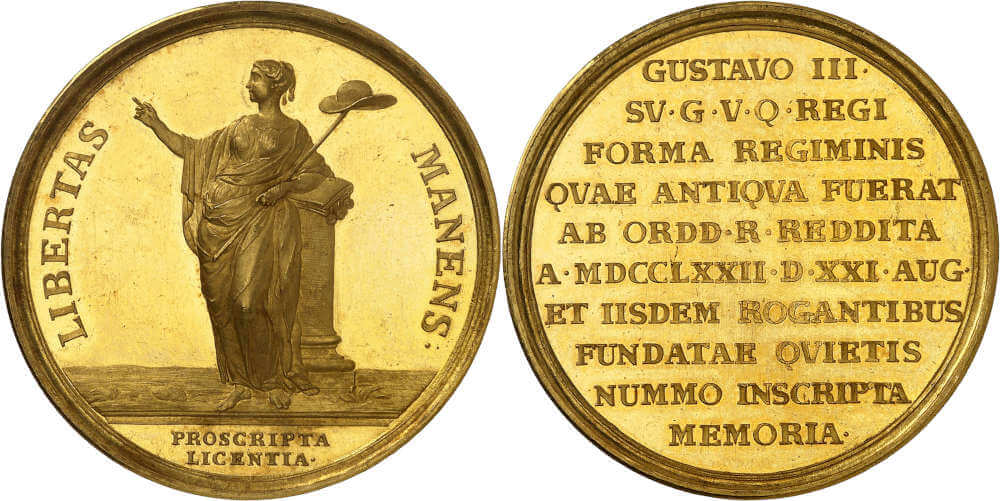
Gustav III. Gold medal of 30 ducats commemorating the unanimous adoption of the new constitution of 1772, created by Gustav Ljungberger, unsigned. From the Gunnar Ekström Collection. Extremely rare. Extremely fine to FDC. Estimate: 15,000 euros. From Künker auction 387 (20 June 2023), No. 21.
The third and last medal of the ensemble is dedicated to the new constitution of 21 August 1772, which was unanimously adopted by the four estates of Sweden – nobility, clergy, bourgeoisie and peasants. It significantly strengthened the king’s position. From then on, the only limit to the king’s powers were the constitution and territorial laws. He had the authority to initiate new bills, and the Estates of Sweden could not pass a law without him. The army was also controlled by the king, and in case of emergency, he could even make the decision about war and peace without consulting the states.
Gustav celebrated this shift in power in his favor as “perpetual liberty” (Libertas Manens). He illustrated the circumscription with the personification of liberty, holding the liberty cap on a staff while leaning on a column stump as a symbol of strength. On this column stump we can see the legislative act with the four seals referring to Sweden’s four estates.
A Masked Ball
However, the new liberty did not have anything to do with what the nobility had imagined. The financial problems that the Swedish treasury was facing due to the ongoing war against Russia caused the king in early 1789 to pass a new law against their will, practically abolishing the council of the realm along with many privileges of the nobility.
The events in France radicalized Gustav even more. In 1791, he supported the attempted escape of the French royal couple and waited for Louis and Marie-Antoinette in Aachen to escort them into exile. The escape failed, the royal couple was imprisoned, and this experience seems to have made Gustav politically unpredictable in the eyes of his contemporaries. To prevent further loss of privileges, a large part of the nobility backed the assassination of the king: it occurred on 16 March 1792 during a masked ball at the Stockholm Opera, almost a year before the French king was executed.
The Widegren Collection illustrates Sweden’s history:
You are currently viewing a placeholder content from YouTube. To access the actual content, click the button below. Please note that doing so will share data with third-party providers.





